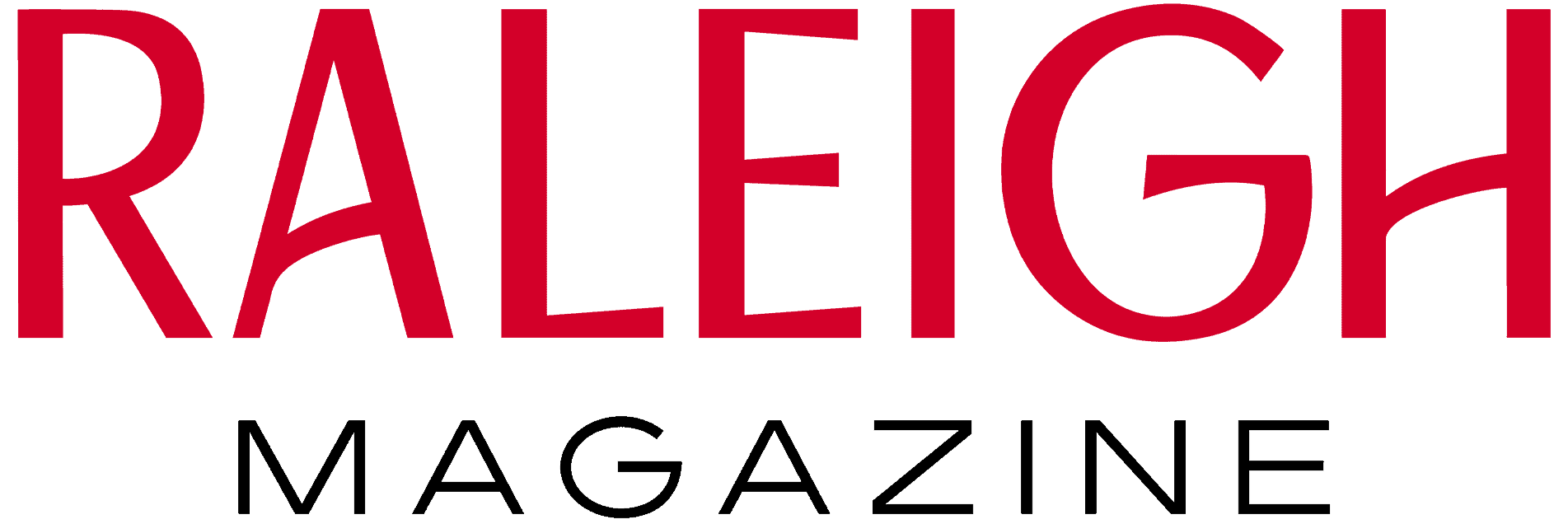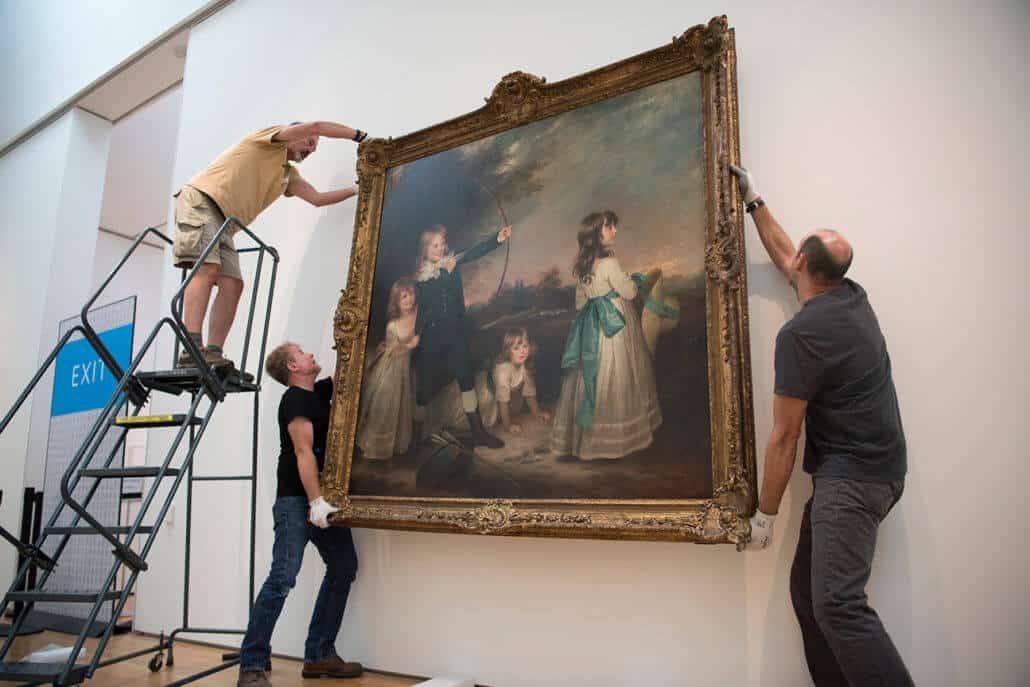Share this Post
Behind-the-scenes museum work requires a cool hand. For Raleigh’s premier art museum, that hand belongs to Tom Lopez.
On a recent Monday morning, the cavernous space with the towering ceilings at the North Carolina Museum of Art stood starkly empty. The 1,900-square-foot gallery’s last occupants had moved out and its bare, white walls were freshly painted all the way to the top of the 18-foot ceilings.
Within the hour, some former occupants would move back in. One of them is Louis XV, the boy king of France—or, more precisely, a portrait of the 18th-century monarch. More than a dozen paintings of other figures from the 16th through 19th centuries will join it.
The pieces from the NCMA’s portrait collection were in storage for nearly a year while a special exhibition occupied their permanent home here in the museum’s portrait gallery. Most of the works belong to the NCMA’s large European collection, recognized as one of the nation’s finest. The expensive assemblage also includes more than 30 sculptures by Auguste Rodin—think “The Thinker.”

Photographs by Karen Malinofski, courtesy of N.C. Museum of Art
Now, these portraits will travel, carefully, from the museum’s storage area back to the portrait gallery for re-installation. That’s no job for a handyman with a claw hammer and a pocketful of picture hangers. It’s a job for an art handler; in this case, Tom Lopez.
Lopez’s work—transporting art, installing it for display and taking it down to move it—sounds simple but the physical management of irreplaceable art in all its forms, shapes and dimensions requires a deft touch and painstaking precision. It’s an art unto itself.
“Tom’s the best I’ve ever worked with,” says Maggie Gregory, the NCMA’s chief registrar, of the soft-spoken, unassuming handler. “He has a deep knowledge of the collection and a sensitivity to the physical nature of art objects.”
Lopez has worked at the NCMA for 32 years. An industrial technology degree and jobs with a sailboat company and in wood shops familiarized him with the tools and techniques he now uses. Lopez also paints abstract art and has shown his work around the state for 35 years, under the name Philip—his first name—Lopez.
Today, Lopez heads up the team responsible for the portrait gallery re-installation, including art handlers Ben Bridgers and Bryce Lankard, both exhibiting artists themselves.
The museum is closed Mondays and, during the lull, Lopez’s team hopes to finish the job before visitors return Tuesday.
The morning begins with the team loading paintings onto a padded, A-frame cart that supports the artwork at an angle, like large panes of glass on a glass installer’s truck. The cart tows the artwork across a courtyard, through the tunnel that connects the museum’s original Blue Ridge Road facility with the newer West Building. It’s a delicate process that takes about an hour.
No two art installations are identical but projects typically begin with a museum curator and a designer planning a layout. If there are didactics, or labels, that accompany the art, curators allow spacing for them.
The art handlers then “spread” the pieces on soft plastic blocks beneath each piece’s designated spot and the designer and curator make any adjustment recommendations.
Then, handlers hang paintings or place sculptures according to an elevation plan that specifies the viewing height for each piece. Finally, they adjust the lighting and apply the labels.
But what happens if a sculpture needs help to stand up straight? What if a painting is too heavy for the usual hanging methods?
“The Kiefer was the most challenging,” says Lopez, unreservedly, of all the pieces that hang on the museum’s wall. It’s an untitled, three-paneled work by the German artist Anselm Kiefer, featuring a cluster of lead-covered boulders suspended from short steel cables among its surface elements. The boulder panel alone weighs 650 pounds.
“No one knew what to do with this huge thing,” Lopez recalls.
He set about fabricating an arrangement of rigging and cleats and eventually managed to install it.
“It was a big deal,” he says proudly. “It was really cool that we could do that.”
Gregory, the registrar, recalls installing an abstract sculpture by the American artist Joel Shapiro. Positioning and rotating the heavy bronze work to determine the best viewing angle was proving cumbersome.
“Tom built a cardboard replica so we could move it easily and agree on the orientation before we installed it,” she says. To hold the angular piece upright, they cemented support rods into holes drilled into the concrete subfloor.
“He enjoys the challenges presented by oversized, undersized or otherwise atypical objects,” Gregory adds, including objects such as vats of molasses and 300 pounds of turkey feathers.
The pieces the team installs today pose no extraordinary challenges, but, Lopez says, he’s always prepared for the unexpected.
Lopez, Bridgers and Lankard have assembled screw guns, drills, ratchet wrenches, hammers, pliers, nails, lag bolts, an assortment of picture hangers to handle any size frame—and, as critical to the art handler as the scalpel is to the surgeon— a tape measure and bubble level.
The crew members wear rubberized gloves for a surer grip and to protect the pieces from hand oil and perspiration. Just how much sweat and oil could transfer to a piece of art?
“Not much,” Lopez says with a smile, but adds, “it’s not your hands that are the problem. It’s the thousands of people before you and the thousands who come after you.”
Hanging the first two paintings is simple as the hooks that held them previously are still in the wall. The remaining pieces, ranging in height from 2 ½ feet to 7 ½ feet, require attaching new mounting hardware to the standard “museum wall,” or drywall layered over plywood. The smaller pieces will be “center-lined,” hung so that their vertical centers line up at the same height on the wall. Larger pieces will be “base-lined—” their frame bottoms will align at the same height.
For each piece, the team measures and nails or bolts hangers into the wall. Two handlers on the floor then lift the paintings, ensuring they stay straight and level and that the frames don’t warp. Another team member on a high, rolling step-ladder maneuvers the pieces onto the hooks.
Once the paintings are hanging, the crew applies a level to the their bottoms and sides to ensure they’re “square.” But sometimes the level lies. Occasionally, the decorative outer frame is not square with the inner frame where the canvas is mounted, or an outer frame— especially one centuries-old—is distorted, rendering the level reading unreliable.
“If only one person picks up a corner, the frame could actually start warping,” Lopez says of the hanging process. Old frames, especially, are notorious for having some warp. “The painting has to be adjusted to please the eye, despite what the bubble on the level might say.”
By late afternoon, the NCMA installation is complete. All the European aristocrats, the Italian cardinal, the French king and a few early American blue bloods once again look down on all the rest of us.

Photographs by Karen Malinofski, courtesy of N.C. Museum of Art
Though today’s was a straightforward installation, Lopez takes nothing for granted.
He takes the same careful approach to dealing with the most valuable pieces as to the less valuable, the same precision in installing pieces quickly as in when he has more time on his hands. Even when he has a deadline and works at twice the speed, Lopez says, he takes pains to install the artwork as if he didn’t have an exhibition schedule.
“You’ve got to follow procedures and treat all [the art] with equal respect,” he says. “But if the Mona Lisa showed up, it might be a little different atmosphere than with some others.”
Whole-gallery installations are art handlers’ most demanding tasks, but pieces in the NCMA’s collection move around constantly. Some art changes display locations in the museum almost daily, for inclusion in a themed exhibit, for instance, or for studying in the museum’s photography studio, conservation studio or examination room for curators and designers. And art handlers must safely transport work for exhibition at local museums, such as UNC’s Ackland, Duke’s Nasher and N.C. State’s Gregg.
“We offer so much more than we used to,” Lopez says of the NCMA’s collection. “We have, easily, a third more paintings than we had in my first years here.”
But one change he’s seen recently discourages him. Where he once observed museum goers “locked in” on paintings and sculptures, Lopez says he sees people enjoying that experience less these days.
“You see a lot of people with cameras,” he notes. “I wish they would look at the painting they’re taking a selfie with.”
Lopez says he meets people who are surprised that his job as an art handler exists and others who are intensely curious about his work behind the scenes. He says, over time, his job has evolved.
“Some days you’re acting almost like a carpenter,” Lopez says. “On other days you feel like you’re a surgeon. Art handling has become more professional; it’s gotten a better seat at the table.”
At that table, the museum staff constantly integrates diverse skills to provide a world-class arts destination to the public.
“We each, on different levels, have our own intimate world with these paintings,” Lopez says of his museum work. “I’m just one of those integrated parts.”
Share this Post





Comments
Tom you have worked hard to get to this spot! Very proud of you. Sure your Dad is keeping up with all you have done. Think of you often.
Tom,
Great to read the article .
If the museum has a huge work loaned ( for instance Anselm Kiefer size ) .
How is the work shipped – especially if it’s going out of the USA ?
Thanks,
Wendy